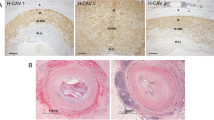Summary
In the cytokine-enriched environment of the chronically rejecting allograft, nitric oxide (NO) is predominantly produced by the inducible isoform of NOS synthase (NOS2) expressed by recipient-derived infiltrating immune cells as well as donor-derived vascular smooth muscle cells and endothelial cells. Early and persistent upregulation of NOS2 in allografts with cardiac allograft vasculopathy and downregulation of NOS2 coinciding with immunosuppressive attenuation of cardiac allograft vasculopathy have suggested NO as a regulator of cardiac allograft vasculopathy, the hallmark of chronic rejection.
Pathogenetically, the development of cardiac allograft vasculopathy can be divided into an early phase, characterized by endothelial dysfunction, and a later phase, characterized by structural changes of vessel wall morphology. Several lines of evidence have shown that NO might play an essential role in both phases.
Endothelial dysfuction due to immune-mediated injury of endothelial cells has been suggested as an early response-to-injury event in the pathogenesis of cardiac allograft vasculopathy. Functional studies in human transplant recipients have documented endothelial dysfunction of coronary artery vessels. Administration of L-arginine, the precursor of NO, improved endothelial function of both epicardial coronary arteris and coronary microvasculature indicating a protective effect of NO.
To assess the impact of NO on the development of late structural changes, the severity of cardiac allograft vasculopathy was assessed in mice with targeted deletion of NOS2. A significant increase of vascular occlusion in NOS2-knockout mice demonstrated an antiarteriosclerotic effect of NOS2. In part, this effect could be explained by reduced neointimal smooth muscle cell accumulation after alloimmune injury.
Taken together, NO plays an important role in maintaining vessel integrity after transplantation. Disruptions in NO pathways seem to play a key role in the progression from endothelial dysfunction to structural changes.
Similar content being viewed by others
Author information
Authors and Affiliations
Rights and permissions
About this article
Cite this article
Koglin, J. Pathogenetic mechanisms of cardiac allograft vasculopathy – impact of nitric oxide. Z Kardiol 89 (Suppl 9), IX24–IX27 (2000). https://doi.org/10.1007/s003920070022
Issue Date:
DOI: https://doi.org/10.1007/s003920070022




